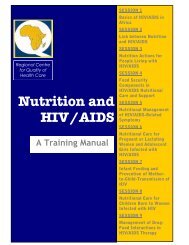2.1: Anthropometric Indicators Measurement Guide - Linkages Project
2.1: Anthropometric Indicators Measurement Guide - Linkages Project
2.1: Anthropometric Indicators Measurement Guide - Linkages Project
You also want an ePaper? Increase the reach of your titles
YUMPU automatically turns print PDFs into web optimized ePapers that Google loves.
TAKING MEASUREMENTS PART 5.<br />
Figure 5.6. Child anthropometry questionnaire (partial)<br />
Section 1: Health and Nutrition<br />
Household ID<br />
0 1<br />
1.1 Anthropometry<br />
Date of interview<br />
dd mm yy<br />
Name<br />
Child<br />
ID<br />
Date of birth<br />
(dd/mm/yy)<br />
Sex<br />
Age 1 = Male<br />
(months) 2 = Female<br />
Weight<br />
(kg 0.1)<br />
Length<br />
(cms 0.1)<br />
0 1<br />
0 2<br />
dd mm yy<br />
dd mm yy<br />
: :<br />
: :<br />
To the nearest<br />
0.1kg and 0.1cm<br />
For Example:<br />
Mary, a girl, born on 7 August 1996, is approximately 11 months old and weighed 10.2 kilograms and<br />
was 67.3 centimetres long<br />
Mary<br />
0 2 0 7 0 8 9 6 1 1 2 1 0 : 2 0 6 7 : 3<br />
dd mm yy<br />
5.6.Training field staff<br />
Training field staff to collect anthropometric<br />
data through surveys usually<br />
involves learning: to take anthropometric<br />
measurements; and other skills such as<br />
household selection, interviewing<br />
techniques and recording requirements.<br />
All of these skills are important for<br />
conducting surveys that yield valid results.<br />
This section will cover what should be<br />
expected from field staff training.<br />
5.6.1 Planning the training<br />
It is recommended that you always select<br />
more candidates than you need. This will<br />
allow you to pick the candidates with the<br />
best performance when training is over<br />
and will give you some extra trainees in<br />
case of dropouts.<br />
The length of the training will vary<br />
depending on the resources available and<br />
the complexity of the survey. As a<br />
guideline, training is generally scheduled<br />
for two to five days. Usually, the first day<br />
of training is spent explaining the purpose<br />
of the survey and outlining the survey<br />
procedures; the second and third days<br />
focus more closely on survey procedures<br />
and the questionnaire; and the last couple<br />
of days should be used for field exercises<br />
and tests. Field exercises will be covered<br />
in more detail later in this section.<br />
The checklist below lists the topics that<br />
should be covered during training:<br />
Purpose and background of the survey<br />
•<br />
division of responsibilities<br />
•<br />
household selection procedures<br />
•<br />
questionnaire<br />
•<br />
Organization of the survey team and<br />
Explanation of sampling and<br />
Question-by-question review of the<br />
Instruction in techniques of interviewing,<br />
recording answers and checking<br />
5.<br />
37

















